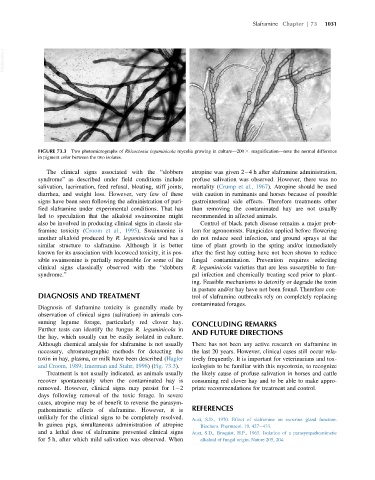Page 1099 - Veterinary Toxicology, Basic and Clinical Principles, 3rd Edition
P. 1099
Slaframine Chapter | 73 1031
VetBooks.ir
FIGURE 73.3 Two photomicrographs of Rhizoctonia leguminicola mycelia growing in culture—200 3 magnification—note the normal difference
in pigment color between the two isolates.
The clinical signs associated with the “slobbers atropine was given 2 4 h after slaframine administration,
syndrome” as described under field conditions include profuse salivation was observed. However, there was no
salivation, lacrimation, feed refusal, bloating, stiff joints, mortality (Crump et al., 1967). Atropine should be used
diarrhea, and weight loss. However, very few of these with caution in ruminants and horses because of possible
signs have been seen following the administration of puri- gastrointestinal side effects. Therefore treatments other
fied slaframine under experimental conditions. That has than removing the contaminated hay are not usually
led to speculation that the alkaloid swainsonine might recommended in affected animals.
also be involved in producing clinical signs in classic sla- Control of black patch disease remains a major prob-
framine toxicity (Croom et al., 1995). Swainsonine is lem for agronomists. Fungicides applied before flowering
another alkaloid produced by R. leguminicola and has a do not reduce seed infection, and ground sprays at the
similar structure to slaframine. Although it is better time of plant growth in the spring and/or immediately
known for its association with locoweed toxicity, it is pos- after the first hay cutting have not been shown to reduce
sible swainsonine is partially responsible for some of the fungal contamination. Prevention requires selecting
clinical signs classically observed with the “slobbers R. leguminicola varieties that are less susceptible to fun-
syndrome.” gal infection and chemically treating seed prior to plant-
ing. Feasible mechanisms to detoxify or degrade the toxin
in pasture and/or hay have not been found. Therefore con-
DIAGNOSIS AND TREATMENT trol of slaframine outbreaks rely on completely replacing
contaminated forages.
Diagnosis of slaframine toxicity is generally made by
observation of clinical signs (salivation) in animals con-
suming legume forage, particularly red clover hay.
CONCLUDING REMARKS
Further tests can identify the fungus R. leguminicola in
AND FUTURE DIRECTIONS
the hay, which usually can be easily isolated in culture.
Although chemical analysis for slaframine is not usually There has not been any active research on slaframine in
necessary, chromatographic methods for detecting the the last 20 years. However, clinical cases still occur rela-
toxin in hay, plasma, or milk have been described (Hagler tively frequently. It is important for veterinarians and tox-
and Croom, 1989; Imerman and Stahr, 1998)(Fig. 73.3). icologists to be familiar with this mycotoxin, to recognize
Treatment is not usually indicated, as animals usually the likely cause of profuse salivation in horses and cattle
recover spontaneously when the contaminated hay is consuming red clover hay and to be able to make appro-
removed. However, clinical signs may persist for 1 2 priate recommendations for treatment and control.
days following removal of the toxic forage. In severe
cases, atropine may be of benefit to reverse the parasym-
pathomimetic effects of slaframine. However, it is REFERENCES
unlikely for the clinical signs to be completely resolved. Aust, S.D., 1970. Effect of slaframine on exocrine gland function.
In guinea pigs, simultaneous administration of atropine Biochem. Pharmacol. 19, 427 433.
and a lethal dose of slaframine prevented clinical signs Aust, S.D., Broquist, H.P., 1965. Isolation of a parasympathomimetic
for 5 h, after which mild salivation was observed. When alkaloid of fungal origin. Nature 205, 204.

